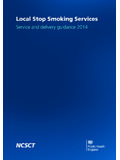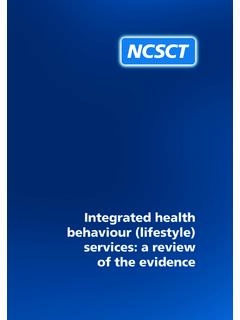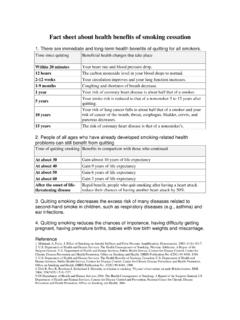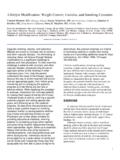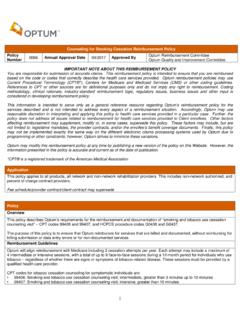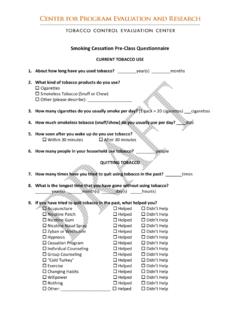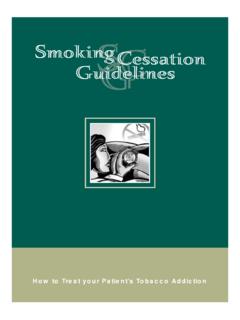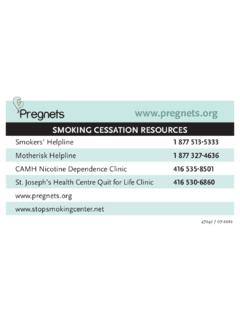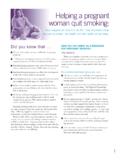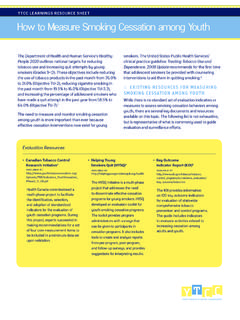Transcription of The effectiveness of NHS smoking cessation …
1 The effectiveness of NHS smoking cessationservices: a systematic reviewLinda Bauld1, Kirsten Bell2, Lucy McCullough2, Lindsay Richardson2, Lorraine Greaves21 Department of Social and Policy Sciences and UK Centre for Tobacco Control Studies, University of Bath, Bath, UK2 British Columbia Centre of Excellence for Women s Health, Vancouver, CanadaAddress correspondence to Linda Bauld, E-mail: analyse evidence on the effectiveness of intensive NHS treatments for smoking cessation in helping smokers to systematic review of studies published between 1990 and 2007. Electronic databases were searched for published reports were identified from the national research register and studies were included. They suggest that intensive NHS treatments for smoking cessation are effective in helping smokers to national evaluation found 4-week carbon monoxide monitoring validated quit rates of 53%, falling to 15% at 1 year. There is some evidencethat group treatment may be more effective than one-to-one treatment, and the impact of buddy support varies based on treatment on the effectiveness of in-patient interventions is currently very limited.
2 Younger smokers, females, pregnant smokers and more deprivedsmokers appear to have lower short-term quit rates than other research is needed to determine the most effective models of NHS treatment for smoking cessation and the efficacy of thosemodels with subgroups. Factors such as gender, age, socio-economic status and ethnicity appear to influence outcomes, but a current lack ofdiversity-specific analysis of results makes it impossible to ascertain the differential impact of intervention types on particular , gender, NHS stop smoking services , smoking cessation , smoking treatment, systematic reviewIntroductionCigarette smoking remains the leading cause of preventabledeath in England today; it is estimated to be responsible forup to 86 500 deaths per year1and costs the National HealthService (NHS) between approximately and billionpounds the publication of the White PaperSmoking Kills,3the UK government has demonstrated astrong commitment to reducing smoking prevalence4through the implementation of an advertising ban, increasesin the price of tobacco, a ban on smoking in workplacesand enclosed public places and the creation of a nationalnetwork of smoking cessation services known as NHSstop smoking stop smoking services represent a unique nationalinitiative to provide support for smokers motivated 6 The service provision framework employed by thesmoking cessation clinics was originally based on theMaudsley model,7an evidence-based approach to treatingdependent ,9 This approach entails regularmeetings (group or one to one)
3 With a trained adviser usingstructured, withdrawal-oriented behavioural therapy com-bined with smoking cessation medications such as nicotinereplacement therapy (NRT), bupropion or the establishment of the services , the Department ofHealth (DH) has required individual primary care trusts(PCTs) in England to monitor the effectiveness of their localservices. This involves regular reporting of the number ofpeople setting a quit date and the number of 4-week monitoring data provides an overview of the volume ofclients treated by the services (over 2 million people between2003 and 2007) but has a number of limitations, not least theLinda Bauld, Professor of Social PolicyKirsten Bell, Tobacco Research CoordinatorLucy McCullough, Research AssistantLindsay Richardson, Research Co-ordinatorLorraine Greaves, Executive Director, BC Centre of Excellence for Women s Health#The Author 2009, Published by Oxford University Press on behalf of Faculty of Public Health.
4 All rights of Public Health | pp. 1 12 | Journal of Public Health Advance Access published July 28, 2009fact that it relies on self-report rather than carbon monoxidemonitoring (CO)-validated ,11In addition to routine monitoring, the DH commissioneda national evaluation of the NHS stop smoking services inEngland between 2001 and 2004; results were published inAddictionin ,13As part of the process of developingsmoking cessation guidance in England,14the NationalInstitute for Health and Clinical Excellence (NICE) com-missioned a systematic review of existing evidence and thisarticle describes findings from this review. The review aimedto analyse available evidence on the effectiveness of inten-sive NHS treatments for smoking cessation and to considerthe differential impact of treatment on subpopulations. Thereview therefore reports findings on the effectiveness of ces-sation interventions in clinical, as opposed to research, set-tings. As such, and in contrast to other reviews of smokingcessation interventions, it provides evidence of effectivenessin real-world methodsThe review was conducted in May 2006 with an update inNovember 2007.
5 The literature search was carried out bythe Centre for Reviews and Dissemination at the Universityof York. Articles from 1990 to 2007 written in English weresearched in the following bibliographic databases: CochraneDatabase of systematic Reviews, Database of Abstracts ofReviews of effectiveness , Health Technology AssessmentDatabase, National Research Register (including CRDongoing reviews database), SIGN Guidelines, NationalGuideline Clearinghouse, HSTAT, TRIP and , because the services have been in existence forless than 10 years, it was expected that some relevant studieswould be found in the grey literature. Grey literature wasaccessed through three avenues: (i) the National ResearchRegister; (ii) the smoking cessation services ResearchNetwork and (iii) tobacco control experts within academiaand be included in the review, studies had to fulfil each ofthe following criteria:(i) They had to examine smoking cessation interventionsprovided within the NHS in the UK.
6 Although thereview focused on England, studies from other parts ofthe UK were included.(ii) The interventions had to be moderately intensive orintensive interventions conducted through the NHS;brief interventions (such as brief advice to stopsmoking by a health professional) were not literature search generated 5131 citations. Before acquiringpapers for assessment, titles were initially scanned by onereviewer who removed the irrelevant studies. The remaining292 abstracts were independently scrutinized by two reviewersand those that did not fulfil the inclusion criteria were elimi-nated. Sixty-nine studies, reports and reviews remained andwere acquired for assessment. Upon examination of the fullarticles, 14 published studies met the inclusion criteria for thisreview. A further 25 reports were acquired through the greyliterature search, and 6 met the inclusion criteria. Thus, in total20 studies were quality assessmentStudies were assessed by two reviewers for their methodo-logical rigour and quality based on the critical appraisalchecklists provided in the NICEP ublic Health GuidanceMethods study was categorized by study typeand graded using a code , or , based on theextent to which the potential sources of bias had been mini-mized (see Tables 1 and 2).
7 Those studies that received dis-crepant ratings from the two reviewers were given to a thirdreviewer for final evaluation. Unpublished data was sub-jected to a quality assessment in the same way as and longer term quit ratesThe overall effectiveness of NHS stop smoking services inEngland was assessed as part of the national evaluation ofservices that reported in 2005. This high-quality study(2 ) described self-report and CO-validated quit rates at4 and 52 weeks. At 4 weeks, 53% of clients were recordedas CO-validated quitters, rising to when self-reportcases were 1 year, of clients wereCO-validated as abstinent, rising to when self-reportcases were results are comparable withprevious trials of intensive smoking cessation interventionspublished in the international literature. Other studiesincluded in this review also reported short- and longer termquit rates but these were either recorded as part of a com-parison of treatment models (described below) or as part ofa study that did not include biochemical validation and wasassessed as poor type and evidence of effectivenessGroup versus one-to-one interventionsTwo high-quality (2 ) observational studies indicate thatgroup treatment for smoking cessation may be more effec-tive than one-to-one ,16 The national evaluation2 JOURNAL OF PUBLIC HEALTHof the services found that although the vast majority ofusers received one-to-one support, group counselling sub-stantially improved (OR.)
8 CO-validated quit study of group treatment for smoking cessationversus one-to-one treatment in primary care also found thatgroup treatment was more indicatedthat 30% of clients receiving group treatment and 19% ofclients receiving one-to-one treatment were CO-validated ascontinuously abstinent at 4 weeks (OR: ).Buddy interventionsSome NHS stop smoking services have experimented with buddy interventions, where individual smokers pair up tooffer each other mutual support with their quit high-quality (1 ) randomized controlled trials(RCTs) have explored the impact of buddy conditions onthe effectiveness of intensive interventions: one in thecontext of individual counselling and the other in thecontext of group counselling. The study exploring buddy interventions in the context of individual counselling17found that the odds of patients in the buddy conditionremaining abstinent (based on CO validation) after 4 weekswas times higher than patients in the solo , the second RCT found that buddy interventionsdid not have an additive effect to group smoking findings of these studies indicate thatwhile buddy systems may be more than double the 4-weekeffectiveness of one-to-one interventions, they do not sub-stantially increase the effectiveness of group interventionsAlthough there has been recent progress in NHS stopsmoking services entering hospital settings19the search onlyidentified one published study that explored the effectivenessof inpatient interventions in a UK setting.
9 This medium-quality (1 ) experimental study focused on whether NRTincreases the effectiveness of inpatient smoking cessationinterventions and included inpatients with smoking -relateddiseases randomized to receive either NRT plus advice andsupport or advice and support study found thatfor both the intervention and control groups the percentageof quitters at 1 year was approximately 14%, which is in linewith the long-term abstinence rates reported for the NHSstop smoking services more of intensity of the interventionon effectivenessThe national evaluation found that CO-validated 4-week quitrates were enhanced by the number of individual sessions in acomplete treatment high-quality evaluation(2 ) of the NHS smoking cessation services in Glasgowalso found that the more intensive smoking treatment servicesTable 1 Level and quality of evidence14 Type and quality of evidence1 High-quality meta-analyses, systematic reviews of RCTs or RCTs (including cluster RCTs) with a very low risk of bias1 Well conducted meta-analyses, systematic reviews of RCTs or RCTs (including cluster RCTs) with a low risk of bias12 Meta-analyses, systematic reviews of RCTs or RCTs (including cluster RCTs)
10 With a high risk of bias2 High-quality systematic reviews of these types of studies, or individual, non-RCTs, case control studies, cohort studies, CBA studies,ITS and correlation studies with a very low risk of confounding, bias or chance and a high probability that the relationship is causal2 Well conducted non-RCTs, case control studies, cohort studies, CBA studies, ITS and correlation studies with a low risk ofconfounding, bias or chance and a moderate probability that the relationship is causal22 Non-RCTs, case control studies, cohort studies, CBA studies, ITS and correlation studies with a high risk or chance ofconfounding bias, and a significant risk that the relationship is not causal3 Non-analytic studies (for example, case reports, case series)4 Expert opinion, formal consensusGrading the evidence High qualityAll or most of the quality criteria have been fulfilledWhere they have been fulfilled the conclusions of the study or review are thoughtvery unlikelyto alter Medium qualitySome of the criteria have been fulfilledWhere they have been fulfilled the conclusions of the study or review are thoughtunlikelyto alter2 Low qualityFew or no criteria fulfilledThe conclusions of the study are thoughtlikely or very likelyto alterRCTs, randomized controlled effectiveness OF NHS smoking cessation SERVICES3 Table 2 Summary of methodological characteristics and main findings of studiesStudy and countryStudy populationResearch question/outcome measure (OM)InterventionResultsAveyardet ,England.



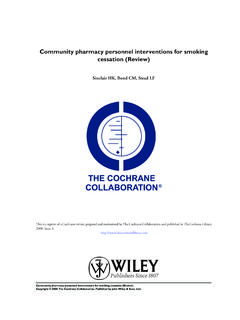

![e-cigarettes briefing [ 2 ] v4 - NCSCT](/cache/preview/0/6/5/c/9/3/f/f/thumb-065c93ffb7496a6f7f874369520a6a6d.jpg)

